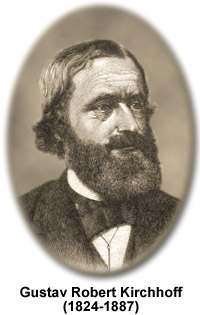Gustav Robert Kirchhoff
(1824-1887)

Gustav Kirchhoff was a nineteenth century physicist who is well known for his contributions to circuit theory and the understanding of thermal emission, but who also made significant discoveries in optics. His work in the area spectroscopy, much of which was carried out in conjunction with chemist Robert Bunsen, was foundational to the field, as was his study of black body radiation. Kirchhoff’s findings are commonly considered to have been instrumental to Max Planck’s quantum theory of electromagnetic radiation formulated at the beginning of the twentieth century.
The son of a lawyer, Kirchhoff was born and educated in Königsberg, Prussia (now the Russian city Kaliningrad). He graduated from Albertus University in 1847 and soon after married Clara Richelot, the daughter of his mathematics professor. The couple immediately relocated to Berlin, where Kirchhoff had obtained an unpaid teaching position. In 1850, at the unusually young age of 26, he received an appointment as Professor Extraordinarius in Breslau (now Wroclaw), Poland. In Breslau, Kirchhoff became acquainted with Bunsen, who urged him to follow him to Heidelberg, Germany, which he did in 1854. As a professor of physics at the university there, Kirchhoff was very successful, but he did suffer personal adversity when his wife died in 1869, leaving him alone to finish raising their four children, a task made more difficult by a disability that often confined him to a wheelchair or to the use of crutches. He remarried, however, in 1872 to Luise Brömmel, and his family remained in Heidelberg until 1875, at which point his failing health inspired him to accept the chair of mathematical physics at the University of Berlin because experimental work was becoming increasingly difficult.
Most of Kirchhoff’s early research was related to electrical currents. While still only a graduate student, he published a paper that included a pair of rules for the analysis of circuits, which are widely utilized in the field of electrical engineering and are now known as Kirchhoff’s laws of circuits. Then, by 1850, Kirchhoff determined that Georg Ohm’s suggestion that electrical flow is analogous to the flow of heat was incorrect and misleading, lending itself to the mistaken assumption that a static current could be present in a conductor. Kirchhoff made another important contribution in this area around 1857, when he noted that an electrical current traveled at approximately the same speed as light. However, he did not make the connection, which was deduced by James Clerk Maxwell in 1862, that light was an electromagnetic phenomenon.
Kirchhoff’s important work on thermal radiation was primarily carried out in the late 1850s and early 1860s. In 1859, his studies led him to propose what is commonly referred to as Kirchhoff’s law in thermodynamics. Proven in 1861, this law holds that at thermal static equilibrium, the emissivity of an object or surface is equivalent to its absorbance at any given wavelength and temperature. In the course of his studies of radiation, Kirchhoff coined the term black body to describe a hypothetical perfect radiator that absorbs all incident light and, therefore, emits all of that light when maintained at a constant temperature in order to preserve equilibrium. The concept of black body radiators is key to the determination of color temperature in the field of photography, but even more importantly, questions raised about black body radiators could not be explained utilizing traditional views of statistical mechanics and electromagnetism. In his attempts to solve these problems, Max Planck made history by discarding contemporary scientific notions and hypothesizing that a black body radiator could only absorb or emit energy in the form of packets he called quanta.
In addition to formulating laws of electrical currents and thermal radiation, Gustav Kirchhoff developed a spectroscope with Robert Bunsen, and the pair pioneered the field of analytical spectroscopy (the study of the emission and absorption of light and other radiation by matter in terms of their relationship to the wavelength of the radiation). Underlying this achievement was Kirchhoff’s demonstration in 1859 that all pure substances display their own characteristic spectrum. Prior to that time, other scientists had postulated that each element had a unique spectrum, but impurities in their samples impeded the discovery since they resulted in the appearance of multiple spectra simultaneously. Equipped with this knowledge, Kirchhoff and Bunsen discovered the elements cesium and rubidium, analyzed the chemical composition of the sun, and explained the dark lines in the solar spectrum generally referred to as Fraunhofer lines, an achievement often considered an important turning point in astronomical studies.
